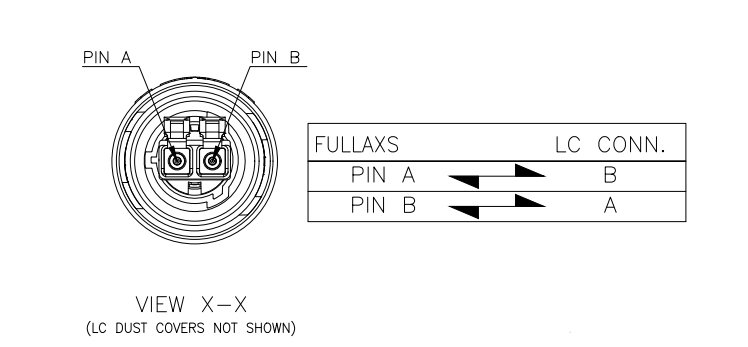CPRI Fiber Optic Jumper Fullaxs Field Install DLC to DLC For FTTA
Tags: Fullaxs DLC, Fullaxs mini, IPFX DLC,DLC to DLC, NSN BOOT, FTTA, RRU, RRH,BBU, CPRI, fullflex mini field install kit,Fiber Optic Jumper,Fiber Optic Cable
Features
- Robust and secure multifiber connector LC
- Factory terminated (testedcables) or field installable version available
- IP67 water and dust protection
- Designed for use in RRUwith pre-chamber solution to protect the LCD connector
- Quick and easy to install

Application
Deployment in Remote Radio Head cell tower applications
For connection between distribution box and RRH
Multi-purpose Outdoor

Specifications

| Type | SM-UPC | SM-APC | MM-UPC | |||
| Typical | Max. | Typical | Max. | Typical | Max. | |
| Insertion Loss | ≤0.15 | ≤0.3 | ≤0.20 | ≤0.3 | ≤0.15 | ≤0.3 |
| Return Loss | ≥50dB | ≥60dB | ≥30dB | |||
| IP Rating | IP67 | |||||
| Temperature, Operation [°C] | -40 to +85 | |||||
Temperature, Installation [°C] | -20 to +60 | |||||

What is CPRI Patch Cord?
A CPRI (Common Public Radio Interface) fiber optic patch cord is a specialized type of fiber optic cable used to connect remote radio units (RRUs) with baseband units (BBUs) in mobile networks. This connection is crucial in the deployment of distributed base stations, particularly in the context of 4G and 5G networks. Here’s an in-depth look at CPRI fiber optic patch cords:
Key Features of CPRI Fiber Optic Patch Cord
High Performance:
- Designed to support the high-speed data transmission requirements of CPRI, ensuring minimal signal loss and high bandwidth capabilities.
Single Mode and Multi-Mode Options:
- Available in both single mode (SM) and multi-mode (MM) variants to suit different deployment scenarios and performance needs. Single mode fibers are typically used for long-distance connections, while multi-mode fibers are used for shorter distances.
Low Insertion Loss:
- Engineered to have low insertion loss, which is crucial for maintaining signal integrity over the fiber link, especially in high-speed data transmission scenarios.
CPRI Protocol Compliance:
- Specifically designed to comply with CPRI standards, ensuring compatibility and reliable performance in mobile network infrastructures.
Connector Types:
- Common connector types include LC, SC, and MPO/MTP, which are used to terminate the ends of the patch cord. LC connectors are often preferred for their compact size and high density.
Durability and Reliability:
- Built to withstand harsh environmental conditions, including temperature variations, moisture, and physical stress, ensuring reliable performance in outdoor and industrial settings.
Applications
Mobile Networks:
- Used extensively in mobile network infrastructure to connect remote radio heads (RRHs) to baseband units (BBUs), facilitating the transmission of data between these components in LTE and 5G networks.
Distributed Antenna Systems (DAS):
- Employed in DAS to extend cellular coverage and capacity, particularly in large buildings and venues where traditional cell towers may not provide adequate coverage.
Small Cell Deployments:
- Used in small cell technology to enhance network capacity and coverage, especially in dense urban environments.
Centralized Radio Access Networks (C-RAN):
- Integral to C-RAN architectures, where multiple base stations are centralized, and their radio heads are distributed closer to the end users.
Advantages
Enhanced Network Performance:
- Ensures high-speed, reliable data transmission, which is essential for the performance of mobile networks, especially with the increasing data demands of 4G and 5G technologies.
Flexibility and Scalability:
- Supports various network architectures and can be easily scaled to meet increasing data demands and evolving network standards.
Cost Efficiency:
- Reduces the need for expensive coaxial cables and associated infrastructure, offering a more cost-effective solution for modern mobile networks.
Example Use Case
In a 5G network deployment, CPRI fiber optic patch cords are used to connect remote radio units (RRUs) mounted on towers or rooftops with baseband units (BBUs) located in centralized data centers. This setup allows for efficient and high-speed data transmission, ensuring that the network can handle the high data rates and low latency requirements of 5G technology.
Conclusion
CPRI fiber optic patch cords are essential components in modern mobile network infrastructure, enabling high-speed, reliable data transmission between remote radio units and baseband units. Their high performance, durability, and compliance with CPRI standards make them a critical choice for LTE, 5G, DAS, and other advanced network architectures.
What is FTTA?
Fiber-to-the-antenna (FTTA) is a wireless site architecture where optical fiber is run all the way up the tower to replace much of what was traditionally completed with heavier coax cabling. Important components such as remote radio units (RRUs) are also positioned at the top of the tower instead of at the base location.
In a FTTA configuration case, a baseband unit (BBU) situated near the bottom of the tower is connected via a fiber optic antenna and runs to a remote radio head (RRH) positioned near the antennas at the top of the tower. The RRH converts the digital signals to analog, and the short span between RRH and antenna is still completed using traditional coax cabling.

